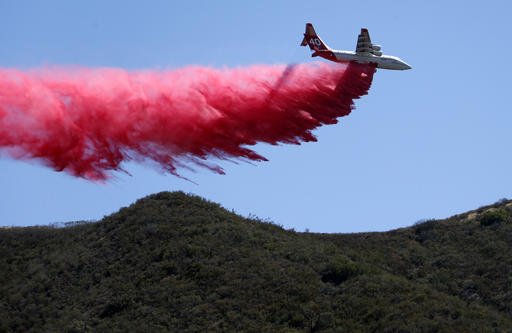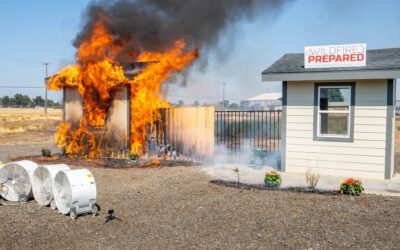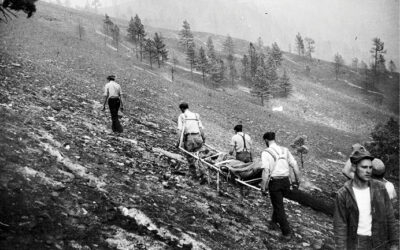Studies find chemicals in fire retardant are harmful to fish and frogs

A plane drops fire retardant on an unburned ridge in advance of flames as a wildfire fire burns in Placerita Canyon in Santa Clarita, Calif., Monday, July 25, 2016. A raging wildfire that forced thousands from their homes on the edge of Los Angeles continued to burn out of control Monday as frustrated fire officials said residents reluctant to heed evacuation orders made conditions more dangerous and destructive for their neighbors. (AP Photo/Nick Ut)
STEVE SCAUZILLO and DAVID DOWNEY, The Press Enterprise
The five hillside homes in Stevenson Ranch resemble the board game Candyland. Brown roofs were turned bright pink. Green shrubs became cotton-candy-colored ornamentals. White patios, sidewalks and stucco walls took on a pinkish hue.
At Gary Fortner’s home, in addition to having a pink house, the swimming pool looked like it was pranked, turning the color of raspberry Jell-O. Pool man Donal Arana had just finished scooping out blobs of the red fire retardant that sank to the bottom more than a week after an errant drop by firefighting airplanes.
Fortner’s ranch-style home was one of five houses in a Santa Clarita neighborhood accidentally doused by a magenta-colored sticky chemical known by the brand name Phos-Chek, a mixture used by the Los Angeles County Fire Department to fight the Sage fire last month that burned 1,109 acres in seven days. Not a single home was lost.
While some say the pink gel is effective at slowing the spread of wildfires, others wonder if its use has long-lasting effects on the environment.
Most agree the chemical is not harmful – at least not to humans and other mammals – even though it can cause quite a mess. However, studies show it may be lethal to aquatic life in lakes, creeks or rivers. And more recently, scientists are concerned about lingering effects of retardant on trees and chaparral during the drought, which has made scarce the cleansing rains that can wash the chemicals away.
“With these drought conditions, with vegetation already stressed and now, with retardant staying on these plants and waiting six months before it rains, we don’t know if that changes the equation,” said Marti Witter, a fire ecologist with the National Park Service at the Santa Monica Mountains National Recreation Area.
“Having salt sitting on your leaves – that would interfere with the leaf surface,” Witter said. “Salts are not that great.”
LAKES AND PONDS
With a U.S. Environmental Protection Agency label as “practically non-toxic,” the red-chemical mixture is mostly harmless to humans and wild mammals, according to documents obtained from several agencies. Some may experience minor, temporary discomforts, documents say.
“During the many years of the evaluated chemicals’ use in firefighting, reports of adverse health effects have been limited to skin and eye irritation and potential allergic reactions,” concluded a study released by the U.S. Forest Service in 2007.
But it’s a different story with aquatic life. Several scientific studies have found the chemicals are toxic to fish and frogs.
According to a 2004 report by Timothy Ingalsbee at the Western Fire Ecology Center: “In still bodies of water like lakes and ponds, concentrated doses of retardant can immediately kill fish, or the nitrogen and phosphorus in retardants can lead to algae blooms that consumes oxygen and kills fish slowly over time.”
WHAT DOES IT MEAN?
According to Forest Service regulations, the high concentration of ammonia and phosphate causes a waterway to become toxic. Frogs and steelhead trout are particularly sensitive, Witter said.
Chad Hanson, research ecologist with the John Muir Project in Big Bear, characterizes fire retardants as a significant threat. And he argues that policymakers should be more discriminating in their use of the retardants.
“For me, what this all means is it’s more evidence pointing to the conclusion that we need to focus on protecting homes and communities, and stop these environmentally destructive fire suppression activities in the more remote forest areas,” Hanson said.
WHAT IS PHOS-CHEK?
Fire retardant is 85 percent water, 10 percent fertilizer and 5 percent minor ingredients such as colorants, anti-corrosive material, thickeners (clay or natural gum), stabilizers and bactericides, according to Forest Service spokeswoman Jennifer Jones.
The fertilizer consists of ammonium phosphate, a salt, which causes the fire retardant to stick to plant material and repel flames. The Phos-Chek is mixed with water according to guidelines supplied to pilots by the Forest Service, Witter said.
How much Phos-Check is dropped on a particular area varies widely, depending on the size of aircraft carrying retardant. Stanton Florea, a spokesman for California’s 18 national forests who is based in Vallejo, said in an email that the largest air tankers deployed by his agency deliver an average of 11,200 gallons per load.
To prevent aquatic life from being harmed by such large dumpings, Florea said Forest Service rules mandate that drops be made at least 300 feet – the length of a football field – away from lakes, rivers, streams, ponds, sensitive habitats and cultural resources.
He said there is one exception: when public safety is threatened and retardant drops are likely to alleviate the threat.
HOW OFTEN DO THEY MISS?
“Each national forest has what’s called a retardant avoidance map,” said John Miller, a spokesman for the San Bernardino National Forest in San Bernardino and Riverside counties. “There are places where we try to our best to avoid.”
Notable examples, Miller said, are the Southwestern arroyo toad habitat along Deep Creek in the San Bernardino Mountains and mountain yellow-legged frog habitat along the North Fork of the San Jacinto River in the San Jacinto Mountains.
Pilots will miss from time to time or wind blows retardant into areas supposed to be avoided. At other times, pilots invoke the public safety exception and purposely go beyond boundaries. Such occurrences are relatively rare, according to Forest Service statistics.
The agency delivered thousands of separate loads of fire retardant on flaming forests across the U.S. last year, Florea said. There were hundreds alone on the 151,000-acre Rough fire that raged across the Sierra and Sequoia national forests and Sequoia-Kings Canyon National Park.
Against that cotton-candy-colored backdrop, Florea said 53 retardant drops landed in areas that were supposed to be avoided.
HOW MUCH IS USED?
When combined, those thousands of loads splashed 11.6 million gallons of fire retardant on national forests nationwide last year.
In the San Bernardino National Forest alone, which was besieged by the 31,000-acre Lake fire, 1.7 million gallons was deposited in 2015, Florea said.
The forest has been more quiet so far in 2016. Still, the forest’s tanker base at San Bernardino International Airport has been tapped to aid firefighters elsewhere in Southern California. And Miller said 1.6 million gallons of fire retardant has been delivered by planes taking off from the base.
“It seems like we continue to break our own records,” he said.
MOSTLY IN THE WEST
Fire retardant is a staple of firefighting in the West. But it’s rarely used in the Northeast and only occasionally in the Midwest, according to the Forest Service. Drops are made on roughly one in 10 fires nationally.
Witter stands by the use of retardant, because it may be effective in limiting the amount of scorched wildlands.
While the effects of higher temperatures, drought and more fires on chemicals’ duration in the environment remains a question that needs study, Witter says retardants are an important fire management tool – especially for putting out fast-moving fires in steep terrain – but only when applied responsibly.
“That means, avoiding sensitive resource areas,” Witter said.




